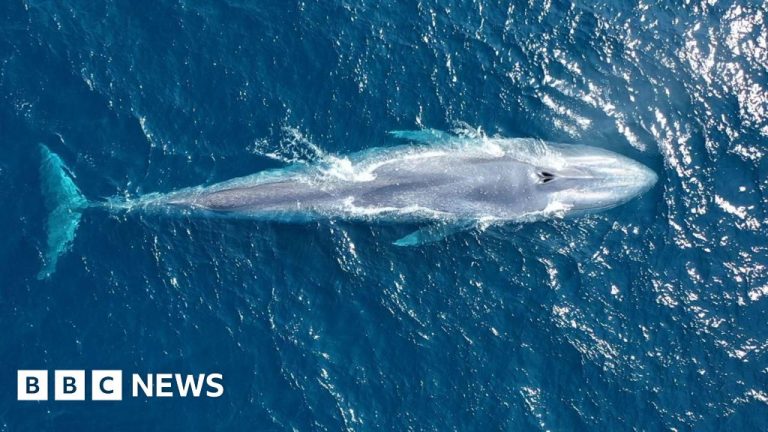Drone footage of pygmy blue whales off the coast of Timor Leste
For about two months each year, fisherman Faustino Mauloko da Cunha turns his home along the southern Pacific coast into a whale monitoring station.
In the morning, villagers and student volunteers gather in the house of Subaun, a village in northern Timor-Leste. Armed with binoculars and telephoto lenses, they monitor the cobalt waters in search of one of its greatest treasures: pygmy blue whales.
When there is a sighting, all systems work.
Faustino's son, Zacarias, sends a drone. Then the team leader, Australian marine ecologist Karen Edyvane, guides him to take the best photographs. When the drone returns, the team reviews the photos and makes notes on a whiteboard.
It's a small, thrifty operation in Timor-Leste, part of an archipelago between Southeast Asia and the South Pacific. But it has generated a wealth of information about pygmy blue whales, one of the largest animals on the planet, whose vast habitats and elusive nature make it difficult to study.
These citizen researchers, all local, have spotted almost 3,000 pygmy blue whales over the past 10 years – Professor Edyvane calls this a “truly extraordinary” number.
Mario Cabral
Faustino Mauloko da Cunha (left) and his son Zacarias with teacher Karen Edyvane in Subaun
Timor-Leste has one of the highest concentrations of marine mammals in the world.
During the migration season – October and November – hundreds of pygmy blue whales cross the country's waters on an epic journey spanning thousands of kilometers from the Banda Sea, which lies north of Timor-Leste , to the south of Australia.
But this area has been understudied, says Professor Edyvane, who launched the citizen science monitoring program in 2014.
For the past two whale seasons, she has been based in Subaun, about 50km from the capital Dili, working with fishermen, students and dive tour operators to document the cetaceans.
They documented “some of the lesser-known intimate reproductive behaviors of blue whales, some for the very first time,” says Professor Edyvane, who teaches at the Australian National University and Charles Darwin University.
In 2022, for example, tourists accompanied by a local tour operator involved in the program captured underwater footage of a mother nursing her young, providing insight into the species' reproductive behaviors, which have remained largely unknown.
“It’s very, very exciting,” she adds.
Hundreds of pygmy blue whales make an epic annual journey from southern Australia, through Timor-Leste and into the Banda Sea.
Zacarias da Cunha
The citizen researchers, all local, have spotted nearly 3,000 pygmy blue whales over the past 10 years.
The program began as a Facebook group inviting local tour operators, fishermen and residents to share their cetacean sightings.
Professor Edyvane trained them in surveying methods and taught them how to use telephoto lenses and drones so they could carry out aerial and boat surveys.
“When locals see the whales swimming, they post photos on Facebook and WhatsApp. The updates happen in real time and when someone shares something, everyone gets very excited,” explains Professor Edyvane.
In 2016, the team worked with a dive tour operator to launch the first whale watching tour.
Only last year did they set up a “research station” outside da Cunha’s village house – photos show a simple cabin overlooking the bay. Outside are two tables, plastic chairs and whiteboards hanging on the walls of the cabin.
Karen Edyvane
The da Cunha Village House Research Station
During this year's whale season, undergraduate students from the National University of Timor-Leste and the Oriental University of Timor-Leste gathered at the research station to assist with sightings.
Even such a basic structure made the task easier.
“We are able to monitor all day and all night,” explains Professor Edyvane. “We were also able to get the most incredible images. The whales come so close that you can sometimes hear their breaths.”
Citizen researchers like these have become powerful eyes and ears on the ground for marine scientists, says wildlife scientist Vanessa Pirotta.
“The combination of people having access to tools like drones and social media means we have a glimpse of what’s happening while we may be behind our desks writing grants to fund our work,” he said. she declared.
The increase in research activities in Subaun has also led to an increase in tourism.
Demand for whale-watching excursions has increased, diving instructor Cassio Schumacher told the BBC, adding that these excursions are “booked years in advance”.
Local non-profit organizations have warned of the risks of unregulated whaling tourism and the government has said it intends to use Professor Edyvane's research to “fully protect and conserve” life. marine which crosses the waters of Timor-Leste.
Karen Edyvane
Faustino Mauloko da Cunha spends most of his day with this camera during whale watching season
Professor Edyvane believes that with regulation, whaling tourism has the potential to create jobs and grow Timor-Leste's economy.
The country is one of the poorest in the world, where the average annual income in cities hovers around $1,500, according to the International Monetary Fund. In Subaun, most villagers work as fishermen and subsistence farmers, earning between $600 and $900 a year.
The da Cunha family has now started preparing meals using local produce and the day's catch for students and tourists – an additional source of income.
“We enjoyed having guests and we would love to do it again,” Faustino, 51, told the BBC in a WhatsApp video call. “We’ll make it a better experience (next season).”
His son, Zacarias, was also hired to provide drone services for the project. Professor Edyvane says she plans to train him to give lectures about whales in English.
The 26-year-old says what he appreciates is that visitors learn how to protect the area: “University students learn quickly and well how to defend this area.”
As for tourists, he says the locals are happy to teach them. “We remind tourists not to swim with the whales but rather observe them from a distance.”

